Résultats de la recherche pour "home OR appliance OR hack OR and OR iot OR guidebook"
-
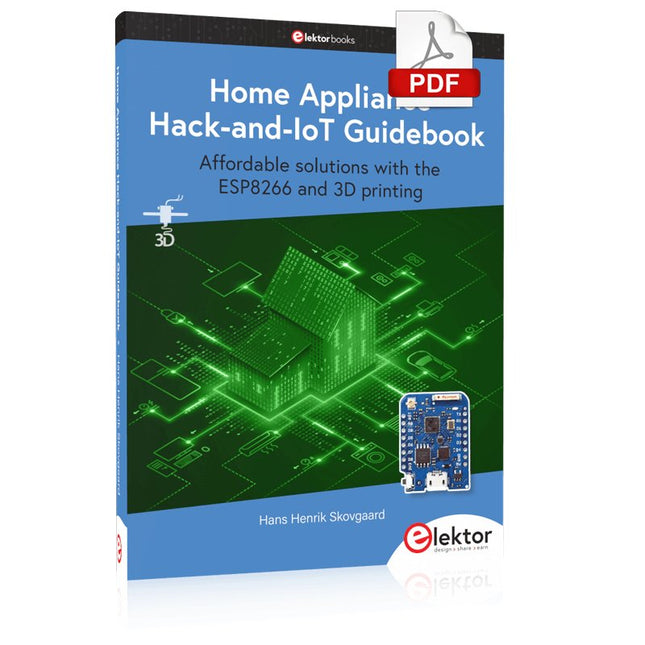
Elektor Digital Home Appliance Hack-and-IoT Guidebook (E-book)
Affordable solutions with the ESP8266 and 3D printing If you are looking for a small yet powerful IoT device, you are likely to come across the ESP8266 and compatible products on the market today. One of these, the Wemos/Lolin D1 Mini Pro board strikes a remarkable balance between cost and performance. A small and very affordable prototype board, the D1 Mini Pro stands out with its WiFi functionality and a 16-Mbytes flash memory for easy creation of a flash file system. In addition, there are sufficient input and output pins (only one analog input though) to support PWM, I²C, and One-Wire systems to mention but a few. The book describes the operation, modding, construction, and programming of home appliances including a colorful smart home accessory, a refrigerator/greenhouse controller, an AC powerline monitor, a door lock monitor, and an IKEA Trådfri controller. As a benefit, all firmware developed for these DIY, "IoT-ized" devices can be updated over-the-air (OTA). For most of the designs in the book, a small printed circuit board (PCB) and an enclosure are presented so readers can have a finished and attractive-looking product. Readers having – or with access to! – a 3D printer can "print" the suggested enclosures at home or in a shop. Some of the constructions benefit from a Raspberry Pi configured as a gateway or cms server. This is also described in detail with all the necessary configuring. You don’t need to be an expert but the prerequisites to successful replication of the projects include basic skills with PC software including the ability to surf the Internet. In terms of hardware, you should be comfortable with soldering and generally assembling the PCBs presented in the book. All custom software written for the IoT devices, the PCB layouts, and 3D print files described in the book are available for free downloading.
€ 34,95
Membres € 27,96
-
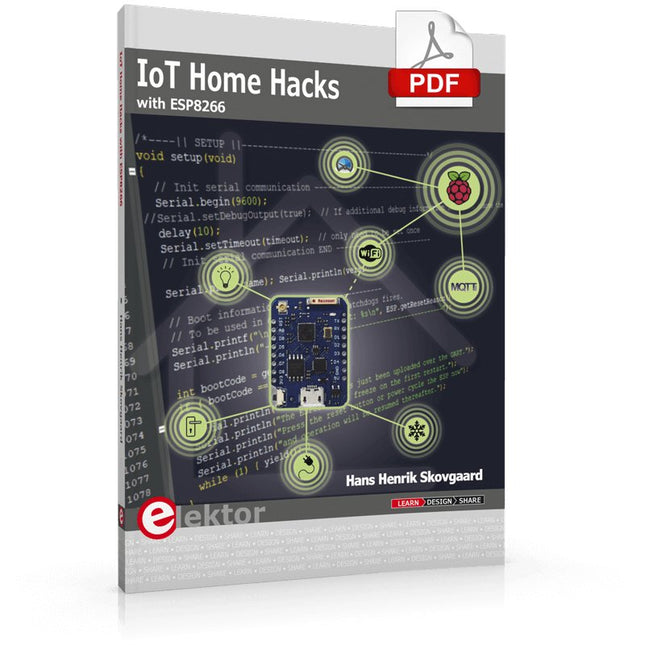
Elektor Digital IoT Home Hacks with ESP8266 (E-book)
There are many so-called 'Arduino compatible' platforms on the market. The ESP8266 – in the form of the WeMos D1 Mini Pro – is one that really stands out. This device includes WiFi Internet access and the option of a flash file system using up to 16 MB of external flash memory. Furthermore, there are ample in/output pins (though only one analogue input), PWM, I²C, and one-wire. Needless to say, you are easily able to construct many small IoT devices! This book contains the following builds: A colourful smart home accessory refrigerator controller 230 V power monitor door lock monitor and some further spin-off devices. All builds are documented together with relevant background information for further study. For your convenience, there is a small PCB for most of the designs; you can also use a perf board. You don’t need to be an expert but the minimum recommended essentials include basic experience with a PC, software, and hardware, including the ability to surf the Internet and assemble PCBs. And of course: A handle was kept on development costs. All custom software for the IoT devices and PCB layouts are available for free download from at Elektor.com.
€ 34,95
Membres € 27,96
-
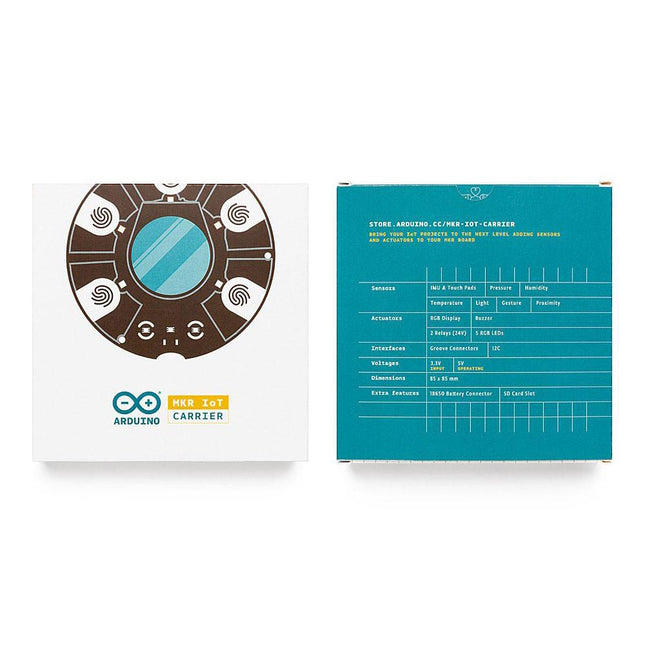
Arduino Arduino MKR IoT Carrier
Acquisition de données : Cartographiez l'environnement autour du porteur à l'aide des capteurs intégrés de température, d'humidité et de pression et collectez des données sur les mouvements à l'aide de l'IMU 6 axes et les capteurs de lumière, de gestes et de proximité. Ajoutez facilement d'autres capteurs externes pour capturer plus de données provenant de plus de sources via les connecteurs Grove integrés (x3) Stockage de données : Collectez et stockez toutes les données localement sur une carte SD, ou connectez-vous au Cloud Arduino IoT pour la capture, le stockage et la visualisation des données en temps réel. Visualisation de données : Visualisez localement les sorties des capteurs en temps réel sur l'écran couleur OLED intégré et créez des invites visuelles ou sonores à l'aide des LED et du buzzer intégrés. Contrôle total: Commandez directement les appareils électroniques à faible tension à l'aide des relais intégrés et des cinq boutons tactiles, l'écran intégré offrant une interface pratique sur l'appareil pour un contrôle immédiat.
€ 59,95€ 29,95
Membres identique
-
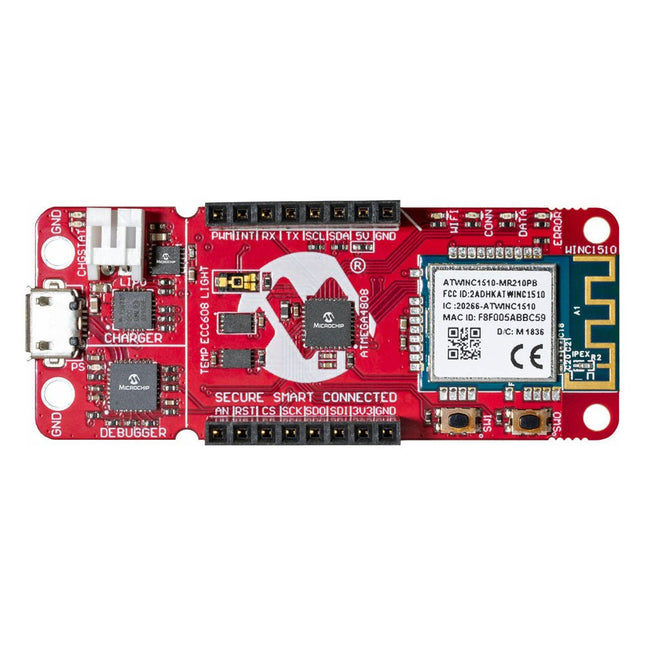
Microchip Carte de développement Microchip AVR-IoT WA
La carte de développement AVR-IoT WA combine un puissant microcontrôleur AVR ATmega4808, un circuit intégré d'élément sécurisé CryptoAuthentication™ ATECC608A et le contrôleur réseau Wi-Fi ATWINC1510 entièrement certifié, qui fournit le moyen le plus simple et le plus efficace de connecter votre application intégrée à Amazon Web Services ( AWS). La carte comprend également un débogueur intégré et ne nécessite aucun matériel externe pour programmer et déboguer le MCU. Prêt à l'emploi, le MCU est préchargé avec une image de micrologiciel qui vous permet de vous connecter et d'envoyer rapidement des données à la plateforme AWS à l'aide des capteurs de température et de lumière intégrés. Une fois que vous êtes prêt à créer votre propre conception personnalisée, vous pouvez facilement générer du code à l'aide des bibliothèques de logiciels gratuits d'Atmel START ou de MPLAB Code Configurator (MCC). La carte AVR-IoT WA est prise en charge par deux environnements de développement intégrés (IDE) primés – Atmel Studio et Microchip MPLAB X IDE – vous donnant la liberté d'innover avec l'environnement de votre choix. Caractéristiques Microcontrôleur ATmega4808 Quatre LED utilisateur Deux boutons mécaniques Empreinte de l'en-tête mikroBUS Capteur de lumière TEMT6000 Capteur de température MCP9808 Dispositif CryptoAuthentication™ ATECC608A Module Wi-Fi WINC1510 Débogueur intégré Auto-ID pour l'identification de la carte dans Atmel Studio et Microchip MPLAB Une LED verte d'alimentation et d'état de la carte Programmation et débogage Port COM virtuel (CDC) Deux lignes DGI GPIO Alimenté par USB et par batterie Chargeur de batterie Li-Ion/LiPo intégré
€ 39,95€ 19,95
Membres identique
-
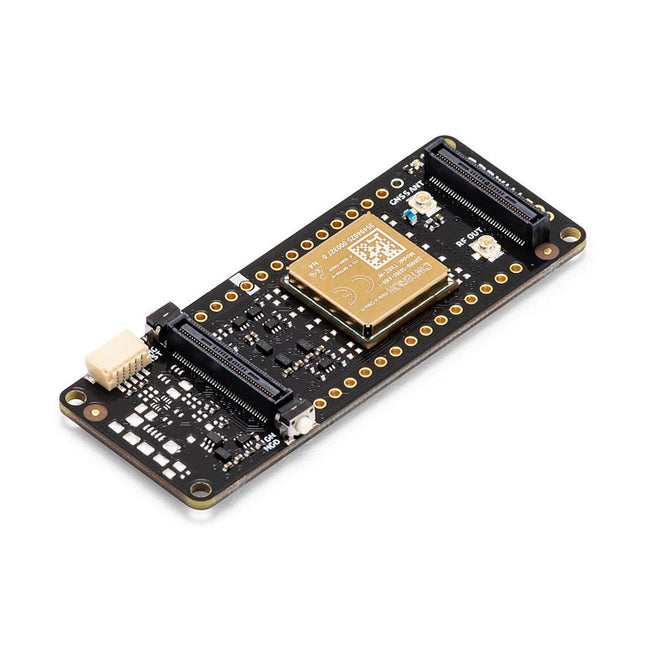
Arduino Arduino Pro Portenta Cat-M1 NB-IoT GNSS Shield
La carte Portenta Cat. M1/NB IoT GNSS Shield vous permet d'améliorer les fonctionnalités de connexions de vos applications Portenta H7. Elle utilise un module sans fil Cinterion TX62 de Thales, conçu pour les applications IoT très efficaces et à faible consommation, afin d'offrir une bande passante et des performances optimisées. La Portenta Cat. M1/NB IoT GNSS Shield s'associe à la forte puissance de calcul de la Portenta H7 pour permettre le développement d'applications de localisation de biens et de surveillance à distance dans les environnements industriels, ainsi que dans l'agriculture, les services publics et les villes intelligentes. La carte offre une connectivité cellulaire aux réseaux Cat. M1 et NB-IoT, avec la possibilité d'utiliser la technologie eSIM. Suivez facilement vos objets de valeur dans toute la ville ou dans le monde entier en choisissant votre GPS, GLONASS, Galileo ou BeiDou. Caractéristiques Changez les capacités de connexion sans changer la carte. Ajoutez NB-IoT, CAT. M1 et le positionnement pour n’importe quel produit Portenta. Possibilité de créer un petit routeur multiprotocole (WiFi - BT + NB-IoT/CAT. M1). Réduisez considérablement les besoins en bande passante de communication dans les applications IoT. Module basse consommation. Compatible également avec les cartes MKR. Surveillance à distance Les entreprises industrielles et agricoles peuvent tirer parti du Portenta Cat. M1/NB IoT GNSS Shield pour surveiller à distance des détecteurs de gaz, des capteurs optiques, des systèmes d'alarme pour machines, des pièges à insectes biologiques, etc. Les fournisseurs de technologies, qui proposent des solutions pour les villes intelligentes, peuvent combiner la puissance et la fiabilité de la Portenta H7 avec la carte Portenta Cat. M1/NB IoT GNSS, afin de connecter les données et d'automatiser les actions pour une utilisation réellement optimisée des ressources et une meilleure expérience utilisateur. Surveillance des biens Ajoutez des capacités de surveillance à n'importe quel bien en combinant les performances et les fonctions d'informatique périphérique des cartes de la famille Portenta. La carte Portenta Cat. M1/NB IoT GNSS Shield est idéale pour surveiller les biens de valeur ainsi que les machines et les équipements industriels. Caractéristiques Connectivité Module sans-fil Cinterion TX62; NB-IoT - LTE CAT.M1; 3GPP Rel.14 Protocole compatible LTE Cat. M1/NB1/NB2; Bandes UMTS: 1 / 2 / 3 / 4 / 5 / 8 / 12(17) / 13 / 18 / 19 / 20 / 25 / 26 / 27 / 28 / 66 / 71 / 85; LTE Cat.M1 DL: max. 300 kbps, UL: max. 1.1 Mbps; LTE Cat.NB1 DL: max. 27 kbps, UL: max. 63 kbps; LTE Cat.NB2 DL: max. 124 kbps, UL: max. 158 kbps Service de messagerie(SMS) Mode texte point à point avec terminaison mobile (MT) et origine mobile (MO) ; mode PDU (Protocol Data Unit). Aide à la localisation Compatible GNSS (GPS/BeiDou/Galileo/GLONASS) Autres Accès intégré aux piles TCP/IP IPv4 et IPv6 ; services Internet : Serveur/client TCP, client UDP, DNS, Ping, client HTTP, client FTP, client MQTT Connexion sécurisée avec TLS/DTLS Démarrage sécurisé. Dimensions 66 x 25,4 mm Température de fonctionnement De -40° C à +85° C (de -104° F à 185°F) Téléchargements · Fiche technique · Schémas
€ 99,95€ 49,95
Membres identique
-
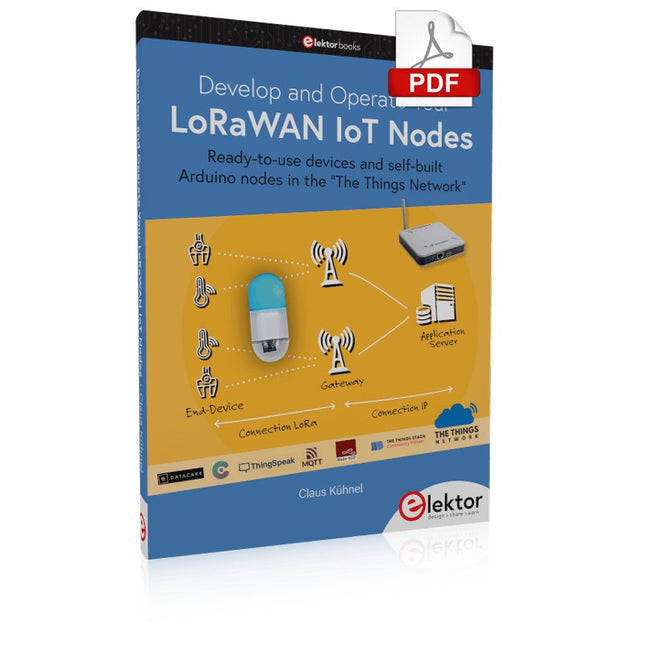
Elektor Digital Develop and Operate Your LoRaWAN IoT Nodes (E-book)
Ready-to-use devices and self-built Arduino nodes in the 'The Things Network' LoRaWAN has developed excellently as a communication solution in the IoT. The Things Network (TTN) has contributed to this. The Things Network was upgraded to The Things Stack Community Edition (TTS (CE)). The TTN V2 clusters were closed towards the end of 2021. This book shows you the necessary steps to operate LoRaWAN nodes using TTS (CE) and maybe extend the network of gateways with an own gateway. Meanwhile, there are even LoRaWAN gateways suitable for mobile use with which you can connect to the TTN server via your cell phone. The author presents several commercial LoRaWAN nodes and new, low-cost and battery-powered hardware for building autonomous LoRaWAN nodes. Registering LoRaWAN nodes and gateways in the TTS (CE), providing the collected data via MQTT and visualization via Node-RED, Cayenne, Thingspeak, and Datacake enable complex IoT projects and completely new applications at very low cost. This book will enable you to provide and visualize data collected with battery-powered sensors (LoRaWAN nodes) wirelessly on the Internet. You will learn the basics for smart city and IoT applications that enable, for example, the measurement of air quality, water levels, snow depths, the determination of free parking spaces (smart parking), and the intelligent control of street lighting (smart lighting), among others.
€ 32,95
Membres € 26,36
-
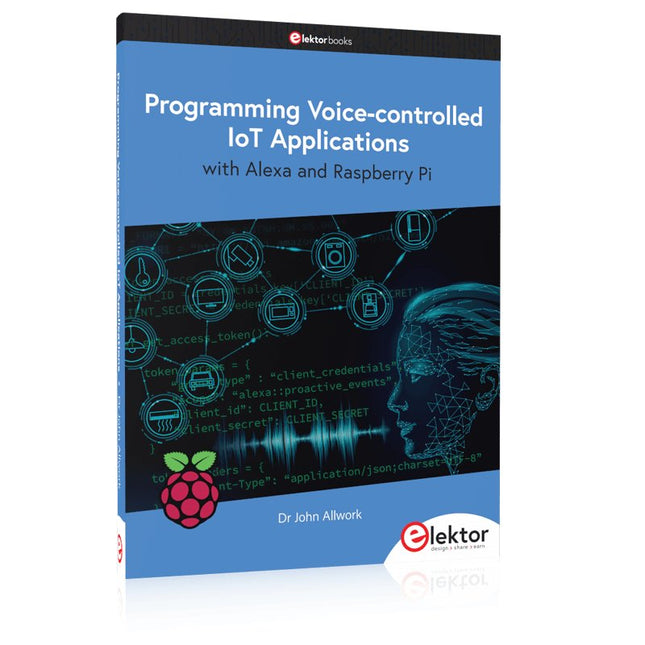
Elektor Publishing Programming Voice-controlled IoT Applications with Alexa and Raspberry Pi
Learn programming for Alexa devices, extend it to smart home devices and control the Raspberry Pi The book is split into two parts: the first part covers creating Alexa skills and the second part, designing Internet of Things and Smart Home devices using a Raspberry Pi. The first chapters describe the process of Alexa communication, opening an Amazon account and creating a skill for free. The operation of an Alexa skill and terminology such as utterances, intents, slots, and conversations are explained. Debugging your code, saving user data between sessions, S3 data storage and Dynamo DB database are discussed. In-skill purchasing, enabling users to buy items for your skill as well as certification and publication is outlined. Creating skills using AWS Lambda and ASK CLI is covered, along with the Visual Studio code editor and local debugging. Also covered is the process of designing skills for visual displays and interactive touch designs using Alexa Presentation Language. The second half of the book starts by creating a Raspberry Pi IoT 'thing' to control a robot from your Alexa device. This covers security issues and methods of sending and receiving MQTT messages between an Alexa device and the Raspberry Pi. Creating a smart home device is described including forming a security profile, linking with Amazon, and writing a Lambda function that gets triggered by an Alexa skill. Device discovery and on/off control is demonstrated. Next, readers discover how to control a smart home Raspberry Pi display from an Alexa skill using Simple Queue Service (SQS) messaging to switch the display on and off or change the color. A node-RED design is discussed from the basic user interface right up to configuring MQTT nodes. MQTT messages sent from a user are displayed on a Raspberry Pi. A chapter discusses sending a proactive notification such as a weather alert from a Raspberry Pi to an Alexa device. The book concludes by explaining how to create Raspberry Pi as a stand-alone Alexa device.
€ 39,95
Membres € 35,96
-
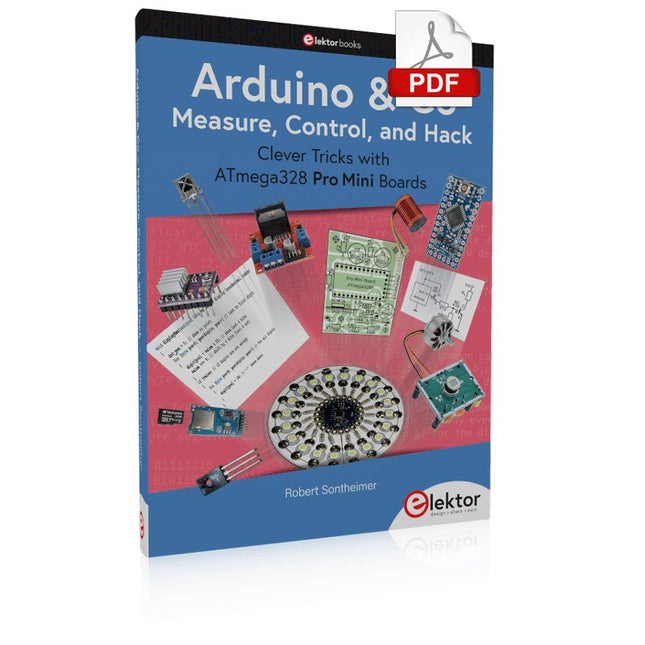
Elektor Digital Arduino & Co – Measure, Control, and Hack (E-book)
Clever Tricks with ATmega328 Pro Mini Boards With a simple Pro Mini board and a few other components, projects that 20 or 30 years ago were unthinkable (or would have cost a small fortune) are realized easily and affordably in this book: From simple LED effects to a full battery charging and testing station that will put a rechargeable through its paces, there’s something for everyone. All the projects are based on the ATmega328 microcontroller, which offers endless measuring, switching, and control options with its 20 input and output lines. For example, with a 7-segment display and a few resistors, you can build a voltmeter or an NTC-based thermometer. The Arduino platform offers the perfect development environment for programming this range of boards. Besides these very practical projects, the book also provides the necessary knowledge for you to create projects based on your own ideas. How to measure, and what? Which transistor is suitable for switching a certain load? When is it better to use an IC? How do you switch mains voltage? Even LilyPad-based battery-operated projects are discussed in detail, as well as many different motors, from simple DC motors to stepper motors. Sensors are another exciting topic: For example, a simple infrared receiver that can give disused remote controls a new lease on life controlling your home, and a tiny component that can actually measure the difference in air pressure between floor and table height!
€ 32,95
Membres € 26,36
-
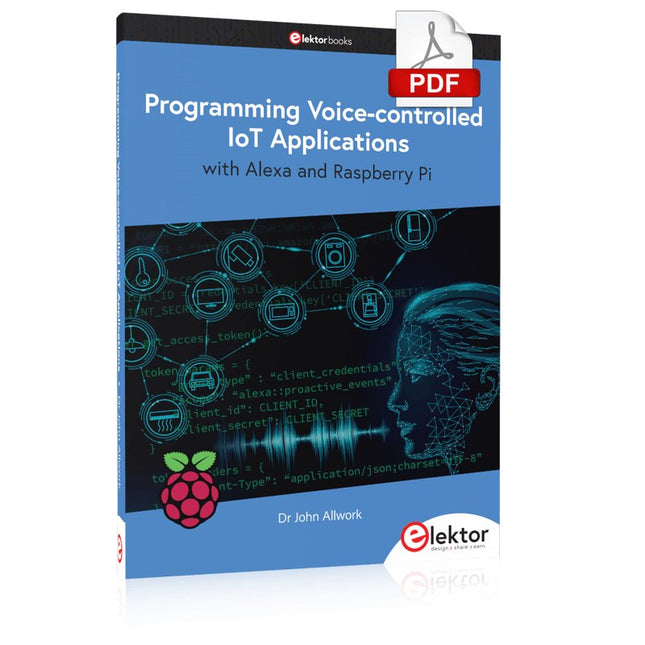
Elektor Digital Programming Voice-controlled IoT Applications with Alexa and Raspberry Pi (E-book)
Learn programming for Alexa devices, extend it to smart home devices and control the Raspberry Pi The book is split into two parts: the first part covers creating Alexa skills and the second part, designing Internet of Things and Smart Home devices using a Raspberry Pi. The first chapters describe the process of Alexa communication, opening an Amazon account and creating a skill for free. The operation of an Alexa skill and terminology such as utterances, intents, slots, and conversations are explained. Debugging your code, saving user data between sessions, S3 data storage and Dynamo DB database are discussed. In-skill purchasing, enabling users to buy items for your skill as well as certification and publication is outlined. Creating skills using AWS Lambda and ASK CLI is covered, along with the Visual Studio code editor and local debugging. Also covered is the process of designing skills for visual displays and interactive touch designs using Alexa Presentation Language. The second half of the book starts by creating a Raspberry Pi IoT 'thing' to control a robot from your Alexa device. This covers security issues and methods of sending and receiving MQTT messages between an Alexa device and the Raspberry Pi. Creating a smart home device is described including forming a security profile, linking with Amazon, and writing a Lambda function that gets triggered by an Alexa skill. Device discovery and on/off control is demonstrated. Next, readers discover how to control a smart home Raspberry Pi display from an Alexa skill using Simple Queue Service (SQS) messaging to switch the display on and off or change the color. A node-RED design is discussed from the basic user interface right up to configuring MQTT nodes. MQTT messages sent from a user are displayed on a Raspberry Pi. A chapter discusses sending a proactive notification such as a weather alert from a Raspberry Pi to an Alexa device. The book concludes by explaining how to create Raspberry Pi as a stand-alone Alexa device.
€ 32,95
Membres € 26,36
-

Phambili Écran IdO Phambili Newt 2,7 pouces (basé sur l’ESP32-S2)
Un écran IdO de 2,7 pouces à faible consommation et à source ouverte, alimenté par un module ESP32-S2 et doté de la technologie Memory-in-Pixel (MiP) de SHARP. Le Newt est un écran mural alimenté par piles, toujours allumé, qui peut aller en ligne pour récupérer la météo, les calendriers, les résultats sportifs, les listes de choses à faire, les citations... vraiment tout ce qui se trouve sur Internet ! Il utilise un microcontrôleur ESP32-S2 que vous pouvez programmer avec Arduino, CircuitPython, MicroPython ou ESP-IDF. Il est parfait pour les makers : La technologie Memory-in-Pixel (MiP, mémoire dans les pixels) de Sharp évite les temps de rafraîchissement lents associés aux écrans E-Ink. Une horloge en temps réel a été ajoutée pour prendre en charge les minuteries et les alarmes. Le Newt a été conçu en tenant compte du fonctionnement sur batterie ; chaque composant a été choisi pour sa capacité à fonctionner à faible puissance. Le Newt a été conçu pour fonctionner « sans fil », ce qui signifie qu'il peut être installé dans des endroits où un cordon d'alimentation ne serait pas pratique, par exemple un mur, un réfrigérateur, un miroir ou un tableau effaçable à sec. Avec le support optionnel, les bureaux, les étagères et les tables de nuit sont également de bonnes options. Il est open source, et tous les fichiers et bibliothèques de conception sont disponibles pour examen, utilisation et modification. Toutefois, cela n'est pas obligatoire. Chacun est livré avec un logiciel fonctionnel comportant les fonctions suivantes : Détails de la météo actuelle Prévisions météorologiques horaires et quotidiennes Alarme Minuteur Citations inspirantes Prévision de la qualité de l’air Calendrier des habitudes Minuteur Pomodoro Carte de stratégie oblique Pour l’utiliser, il suffit de suivre les instructions pour le connecter au Wi-Fi. Aucun téléchargement d'application n'est nécessaire. Spécifications Affichage LCD à mémoire vive Taille de l’écran 2,7 pouces Résolution 240 x 400 Courant de veille 30 μA Taux de rafraichissement Rafraîchissement périodique de l'écran requis Non Boutons d’entrée 10 boutons capacitifs, 1 bouton-poussoir RTC inclus Oui Haut-parleurs inclus Oui Entrée d’alimentation USB Type-C Batterie incluse Non Languages de programmation Arduino, CircuitPython, ESP IDF, MicroPython Dimensions 91 x 61 x 9 mm Microcontrôleur Module expressif ESP32-S2-WROVER avec 4 Mo de flash et 2 Mo de PSRAM Compatible Wi-Fi Supporte Arduino, MicroPython, CircuitPython, et ESP-IDF Courant de veille profonde aussi faible que 25 μA Affichage Mémoire en pixels LCD 2,7 pouces, 240 x 400 pixels Capable de fournir un contenu à haut contraste, haute résolution et faible latence avec une consommation d’énergie ultra-faible Le mode réfléchissant exploite la lumière ambiante pour éliminer le besoin d’un rétroéclairage Chronométrage, minuteries et alarmes Horloge temps reel (RTC) Micro Crystal RV-3028-C7 Optimisé pour une consommation extrêmement faible (45 μA) Capable de gérer simultanément une minuterie périodique, un compte à rebours et une alarme Interruption matérielle pour les minuteries et les alarmes 43 octets de mémoire utilisateur non volatile, 2 octets de RAM utilisateur Compteur de temps UNIX séparé Audio Haut-parleur/ronfleur avec mini amplificateur classe D sur la sortie A0 du CNA, pouvant jouer des tonalités ou des clips audio lo-fi. Entrée utilisateur Interrupteur d’alimentation Deux boutons tactiles programmables pour réinitialiser et démarrer 10 pavés tactiles capacitifs Alimentation Newt est conçu pour fonctionner pendant un à deux mois entre les charges en utilisant une batterie lipo de 500 mAh. Cette durée varie (une utilisation intensive du Wi-Fi, en particulier, déchargera plus rapidement la batterie). Connecteur USB de type C pour la programmation, l'alimentation et la charge Régulateur de tension à mode de fonctionnement vert (TOREX XC6220) qui peut sortir 1 A de courant et fonctionner à partir de 8 μA Connecteur JST pour une batterie Lithium-Ion Chargeur de batterie (MCP73831) Indicateur de batterie faible (courant de repos de 1 μA) Logiciel Le matériel Newt est compatible avec les bibliothèques open source Arduino pour ESP32-S2, Adafruit GFX (polices de caractères), Adafruit Sharp Memory Display, et RTC RV-3028-C7 (RTC) Les bibliothèques Arduino et les exemples de programmation sont disponibles dans le dépôt GitHub du fabricant Les bibliothèques CircuitPython et l'enregistrement sont sur la feuille de route, incluant une bibliothèque CircuitPython pour l'horloge en temps réel RV-3028 Inclus dans le colis Phambili Newt – entièrement assemblé avec firmware préchargé Support de bureau découpé au laser Pieds à mini-aimant La visserie nécessaire Support et documentation Instructions complètes d’utilisation (En anglais) GitHub: bibliothèque et base de code Arduino (En anglais) GitHub: schémas de la carte (En anglais) Vidéos de prototypes ou de démonstrations (build tracked on Hackaday. En anglais)
€ 144,95€ 72,50
Membres identique
-
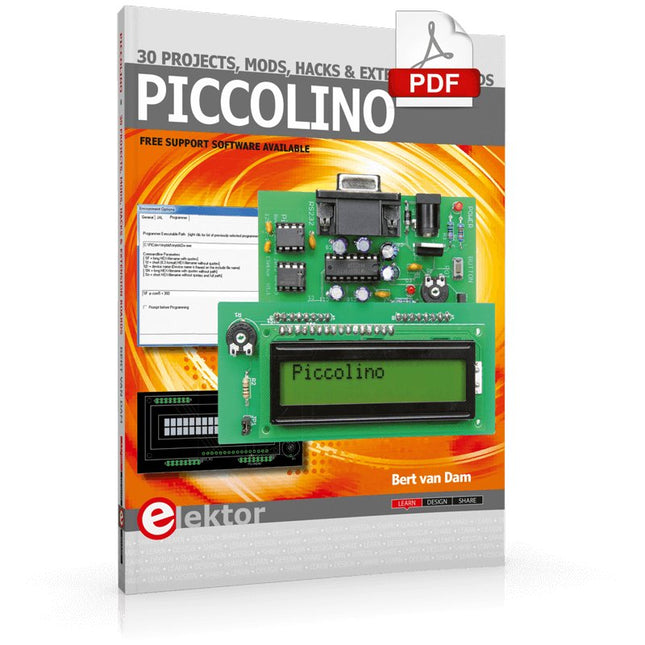
Elektor Digital Piccolino - 30 Projects, mods, hacks and extension (E-book)
The Piccolino rapid development board can be used to design microcontroller circuits quickly. The Piccolino has a fast 16f887 PIC microcontroller, voltage regulator, and communications module, and can be easily extended using its four headers. This e-book contains 30 projects based on the Piccolino. We'll use its unique communications facilities and get the Piccolino to communicate with programs on a PC. On the PC, we use the free programming language Small Basic. You can use this to create Windows programs with buttons and graphs quickly. You will learn how to analyze components such as inductors, capacitors, and OPAMPs, and how to display the measurement results in a graphical format. This will help you to design your circuits easily. We will then start to adapt to the Piccolino. We'll add components to it to make it more powerful, with extra features such as flow control and digital to analog conversion. The clear instructions will enable you to design and build your adaptations. This way you can make your custom designed Piccolino. We'll end up making an extension: a PCB that that can be mounted on the Piccolino headers. As an example, we'll design and build an extension for an LCD. You can use the included board layout to make your PCB or have it made for you. At the same time, you will learn how to make your extensions. The only limitation is your imagination! The clear descriptions along with circuit diagrams and photos, will make the building of these projects an enjoyable experience. Each project has a clear explanation of the reasons why it was designed in a particular way. This helps you learn a lot about the Piccolino, as well as Small Basic, and the components that are used in this e-book. You can adapt the projects to suit your requirements or combine several projects.
€ 34,95
Membres € 27,96
-
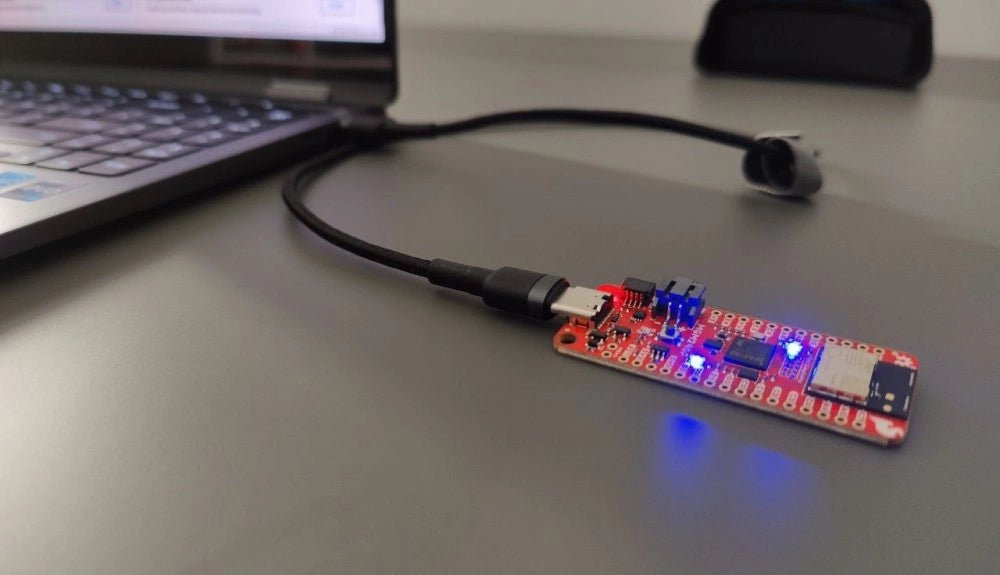
, par Saad Imtiaz SparkFun Thing Plus Matter (MGM240P) : Une carte de développement IoT polyvalente basée sur "Matter" (Essai)
La "SparkFun Thing Plus Matter - MGM240P" est une carte de développement polyvalente et riche en fonctionnalités, conçue pour réaliser des appareils IoT basés sur...











